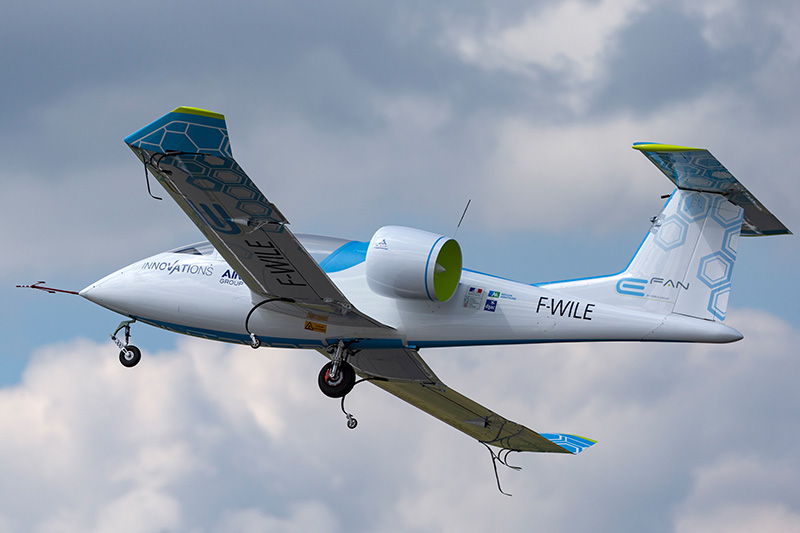Market Connector: Electric, Hybrid-Electric and Hydrogen-Powered Aircraft
-2.jpg)
Electric and hybrid-electric power is becoming more popular among consumers for commuter vehicles, and these technologies are rapidly being tested and scaled for use in commercial and military ground vehicle systems too. Development of similar electrified and hybrid-electric, eco-friendly systems for the air, particularly for larger commercial air travel, is following close behind.
eVTOL development has rapidly taken shape in recent years, and rollouts of these vehicles are expected this decade particularly to fill the role of Urban Air Mobility. But weight limitations, battery energy density, and a host of other factors make incorporating electrification concepts and sustainable aviation fuel (SAF) into larger aircraft propulsion systems a challenging task.
A lot of work is being done throughout the aviation industry to address the design and operational challenges posed by electric, hybrid-electric, and SAF-powered airframes for larger commercial aircraft. Addressing these challenges has the potential to revolutionize air travel.
Who: Major players in aerospace such as Boeing, Airbus, General Electric, BAE Systems, RTX, and others are at the forefront of developing these platforms.
BAE Systems, for example, is focusing on the development of energy management systems, integrated control systems, and power conversion to unlock the development of hybrid-electric and fully-electric aircraft.
Meanwhile, Airbus is exploring hydrogen combustion and fuel-cell propulsion technologies. The company has launched demonstrators for these technologies and has even established a joint venture with automotive supplier ElringKlinger AG, known as Airbus Aerostack GmbH, to develop hydrogen fuel cell stacks for electric propulsion systems.
Airbus’ ZEROe project aims to bring to market the world’s first hydrogen-powered commercial aircraft. In late 2023, the ZEROe teams powered on the iron pod, the future hydrogen-propulsion system designed for Airbus’ electric concept aircraft.
Pratt & Whitney, an RTX company, has delivered hundreds of its PT6 E-Series turboprop engines. The PT6 E-Series is an electrified configuration of Pratt & Whitney Canada’s PT6 engine that was originally introduced in the 1960s and still sees widespread use today.
These are just a few of the leading innovators in this field.
 An early Airbus prototype electric aircraft, the Airbus E-Fan, mid-flight in 2014. [STOCK IMAGE]
An early Airbus prototype electric aircraft, the Airbus E-Fan, mid-flight in 2014. [STOCK IMAGE]
What: The markets for these new types of aircraft are projected to grow substantially in the years to come as this technology matures.
The hybrid-electric market alone is projected to grow to more than $27 billion by 2032, while the market for hydrogen-powered aircraft could exceed $27 billion by 2030. The market for electric aircraft could be worth as much as $23 billion by the early 2030s.
Where: Research and development efforts are spread across the world. Key players in the United States, Europe, and Asia are actively pursuing the advancement of electric and hybrid electric aviation technology.
When: The development of electric and hybrid electric commercial aircraft is ongoing, with significant milestones expected in the 2020s and beyond. Some smaller electric aircraft are already in operation for short-haul flights, while larger commercial planes are in the testing and prototyping phase, aiming for commercial viability within the next decade. eVTOL aircraft are inching toward viability and usage throughout major cities and other areas of the globe this decade too.
Why: Beyond environmental sustainability, the development of electric, hybrid-electric, and hydrogen-powered airframes is slated to bring a variety of benefits for passengers. For starters, cabins could be a lot less noisy due to the quieter electric powertrains. Electric and hybrid-electric engines may offer less vibration than traditional combustion aviation engines too, resulting in an airframe that offers a smoother travel experience.
From an operational standpoint, these aircraft are expected to be more efficient and environmentally friendly as well. An electric aircraft powertrain could enjoy more than 90% efficiency, meaning 90% of the electrical energy put into the system is converted into mechanical energy to propel the aircraft. In comparison, current large turbofan engines are about 55% efficient.
The development of this new aircraft propulsion technology is going to require much more complex electrical systems with advanced power systems, energy storage technologies, and electrical distribution systems. This means interconnect systems designed to facilitate high voltage and amp requirements are going to be essential.
About Us
Amphenol Aerospace is an industry-leading designer and manufacturer of interconnect products for the military and aerospace markets.
Search for parts through our Technology guide, or visit our Product Configurator to get 3D models of the exact configuration that you are looking for.